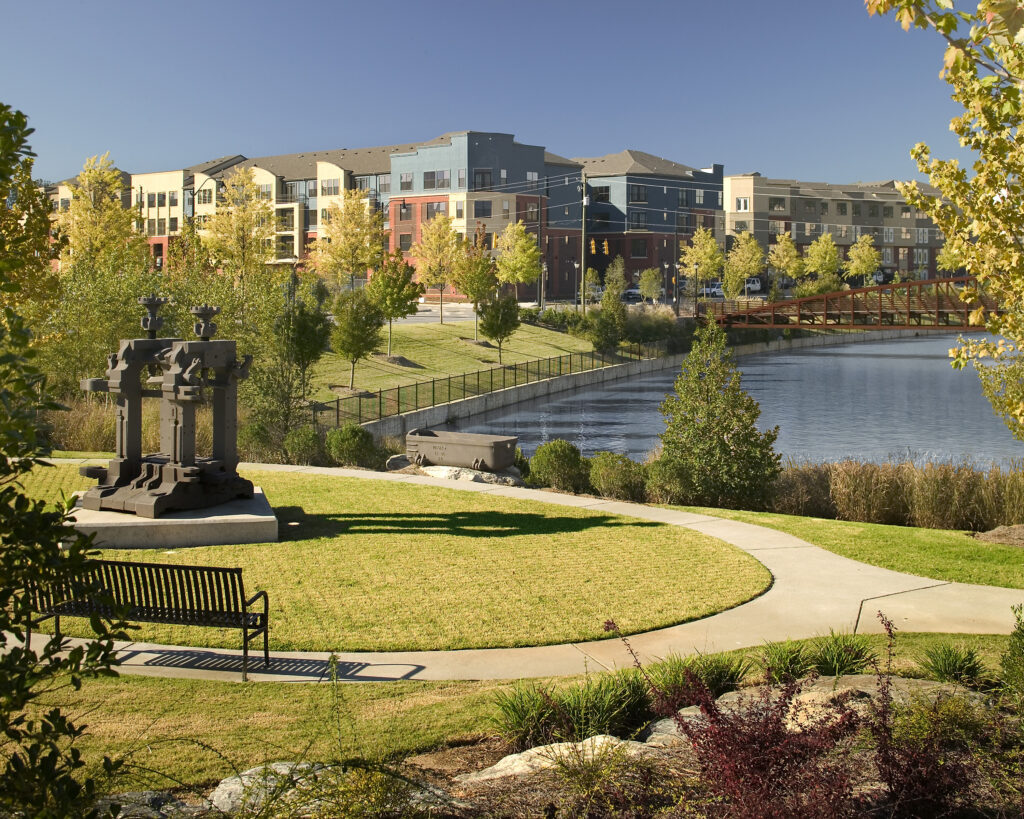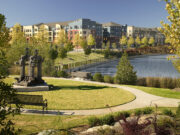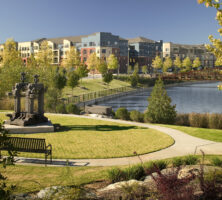New Urbanism is a late-twentieth-century architectural and urban design movement that has influenced the landscapes of cities and towns in Georgia. New Urbanism endeavors to guide the development of the built environment at all scales, from the individual building to the region. Counter to decades of suburban sprawl and pervasive automobile-oriented design, New Urbanist practice seeks to restore a balance between cities and suburban development through an understanding of the best traditions of urbanism. As a paradigm, it stands in contrast to the hegemony of suburban planning strategies outlined by the International Congress for Modern Architecture, which have been popular since the 1940s.

Courtesy of Atlantic Station
New Urbanism’s primary focus is to enable a higher quality of life by offering new choices for living that are less dependent on automobiles. It promotes the revitalization of downtown and main streets, structures new development as real neighborhoods, and encourages the conservation of natural environments and the preservation of our built legacy through the creation or restoration of pedestrian-responsive and diverse compact towns and cities. Projects include prototypes for new suburban development, infill in existing urban areas, redeveloped neighborhoods, and public housing developments, as well as metropolitan and regional guidelines for development. The Congress for the New Urbanism, consisting of architects, designers, developers, elected officials, and academics, was formed in 1993 to further advance the philosophy. The charter, adopted in 1996, sets out twenty-seven basic principles of urbanism, each organized under one of three categories, that should guide public policy, development practice, urban planning, and design.
Metropolis, City, and Town
New Urbanist practice begins at the regional scale. According to New Urbanist principles, metropolitan regions are finite places with geographic boundaries derived from topography, watersheds, coastlines, farmlands, regional parks, and river basins, and they have a fragile relationship with these landscapes. Development patterns should not blur or eradicate the edges of the metropolis. Cities and towns should bring into proximity a broad spectrum of public and private uses to support a regional economy that benefits people of all incomes. Destructive competition for the tax base should be controlled through revenue and resource sharing, and through the promotion of rational coordination of transportation, recreation, public services, housing, and community institutions. Architecture and landscape design should grow from local climate, topography, history, and building practice.
Metropolitan regions should encourage infill developments in proximity to other existing areas, over peripheral, suburban expansion. The development and redevelopment of towns and cities should respect historical patterns, precedents, and boundaries. Such activities should also create high-quality environments free from noise, pollution, toxins, and danger, including streets that are safe for walking along, as well as clean air, water, and food. Another integral part of a high-quality environment is a reliable transportation system that facilitates travel for everyone both locally and regionally. Finally, New Urbanism calls for a combination of beautiful architecture with great urbanism to create beautiful places in which to live.
Neighborhood, District, and Corridor
The neighborhood, the district, and the corridor are the essential elements of development and redevelopment in the metropolis. They form identifiable areas that encourage citizens to act responsibly for their maintenance and evolution. Neighborhoods should be compact, pedestrian friendly, and mixed use, with many activities within walking distance of one another to reduce automobile trips and conserve energy. Neighborhoods or districts should consist of a broad range of house types and price levels in order to strengthen personal and civic bonds. Transit corridors should complement and organize the relation between towns with appropriate building densities and land uses within walking distance of transit stops. Civic, institutional, and commercial activity should be embedded in neighborhoods and districts, not conducted in isolated, remote, single-use complexes. Conservation areas and open lands should be used to define and connect different neighborhoods and districts.
Block, Street, and Building
The accommodation of automobiles as well as pedestrians and other forms of transportation begins with urban design practices that reinforce the human scale while incorporating the necessities of contemporary life. A primary task of urban architecture is to promote the physical definition of streets and public spaces as places of shared use that encourage pedestrian interaction and civic identity. Civic buildings and public gathering spaces are recognized as important sites that reinforce community identity and the culture of democracy. All buildings conforming to New Urbanist principles should provide their inhabitants with a clear sense of location, weather, and time, while the preservation and renewal of historic buildings, districts, and landscapes should affirm the continuity and evolution of urban society.
New Urbanism as a practice seeks the highest quality environment and includes a full range of services within a five- to ten-minute walk of every residence. At minimum, this would include grocery stores, delis, bakeries, newsstands, coffeehouses, vegetable stands, open-air markets, personal service providers, parks, and green spaces. A full range of entertainment and cultural activities are also desirable, all in an attractive, friendly atmosphere. Such an environment requires a street design that encourages parity between automobile and pedestrian traffic by promoting slower driving speeds. The revitalization of urban places depends on safety and security—building and street design should reinforce this concern.
New Urbanism in Georgia
Many years of historic preservation and sensitive development have created environments in Athens, Madison, and Savannah that display the principles of New Urbanism. Because New Urbanism is essentially an empirical practice, based on the best examples of good urbanism, these Georgia places are significant to the movement. Town Center of Smyrna and Duluth Town Green, both designed by the Sizemore Group, adhere to New Urbanist principles, but one of the best articulations of this philosophy in Georgia is Glenwood Park in East Atlanta, which features traditional neighborhood design, pedestrian-friendly spaces, and environmental management practices. Glenwood Park was recognized with a 2003 Charter Award by the Congress for the New Urbanism. Other examples of New Urbanist developments in Georgia include Atlantic Station on Atlanta’s west side; Clark’s Grove in Covington; and New Manchester and Perimeter Town Center in Atlanta.






